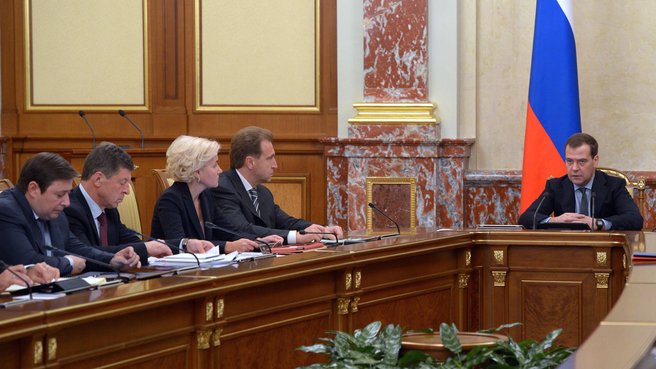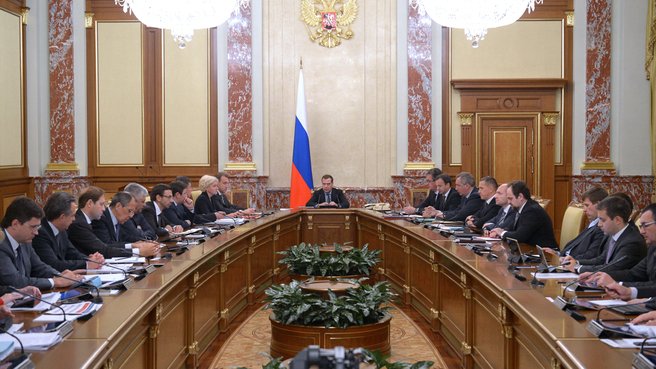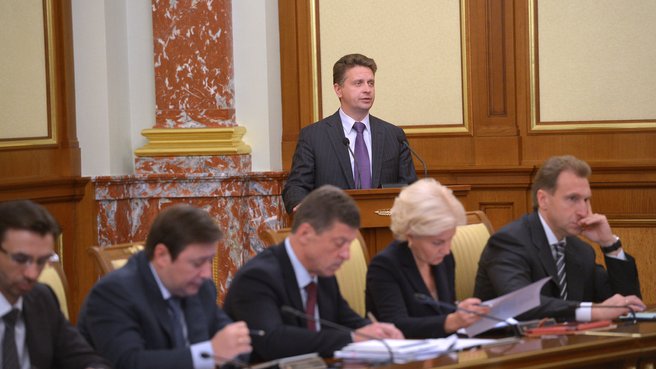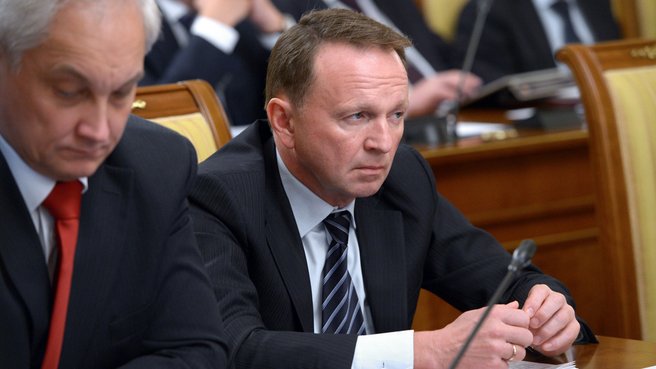Agenda: Inland water transport development, Siberia’s socioeconomic development strategy, and 10 other issues.
Dmitry Medvedev’s introductory remarks
Minister of Transport Maxim Sokolov's report
Remarks by member of the Government Expert Council Sergei Maltsev
Remarks by Deputy Prime Minister Arkady Dvorkovich
Remarks by Minister of Finance Anton Siluanov
Transcript:
Dmitry Medvedev: There are some issues which I’d like to discuss before others at this Government meeting. The first concerns the development of inland water transport, which is the number one issue on our agenda today. The situation in this area has greatly deteriorated in the past few decades. More than a quarter of our waterway facilities like sluice gates and dams are not up to the latest standards – and this is an optimistic figure. Unfortunately, the safety standards are low, which puts major constraints on navigation, primarily in some areas of the Unified Deep Water System of European Russia.
This slows down the ships, reduces their load capacity and ultimately makes our rivers inconvenient for use and also uncompetitive, which is bad because water transport should be the cheapest option. This situation is the result of insufficient funding over the years. The current allocations are not even enough to pay for maintenance costs, and private investors are few and far between.
Given that one quarter of federal roads are systematically congested, while railway transport is operating at its full capacity (the length of railway bottlenecks has expanded by 20%), we should make rational use of our natural transportation network, which is inland water transport. Suffice it to say that this means of transport accounts for 10% of the total freight turnover in such major European industrialised nations, as Germany and France.
Dmitry Medvedev: The Ministry of Transport has devised an Inland Water Transport Development Strategy to 2030. It is clear that the development of river transport will be conducive to traffic flow redistribution, will help rationalise the handling of oversize heavyweight cargo and will ensure that transport services are available on socially significant routes in Russia’s Far East, Far North and Siberia, taking into account that water transport is often the only way to reach the mainland there.
The Ministry of Transport has devised an Inland Water Transport Development Strategy to 2030. It is clear that the development of river transport will be conducive to traffic flow redistribution, will help rationalise the handling of oversize heavyweight cargo, which, strictly speaking, can be transferred only by water, and will ensure that transport services are available on socially significant routes in Russia’s Far East, Far North and Siberia, taking into account that water transport is often the only way to reach the mainland there.
The strategy was published on the website of the Ministry of Transport in August, and has been reviewed by the Government Expert Council.
We will also hear today a progress report on the Strategy for the Social and Economic Development of Siberia to 2020 and will discuss a draft programme on state guarantees regarding medical care, which is provided to the population for free regardless of where they live. This is a very important constitutional guarantee for every Russian citizen, so it should be duly implemented in practical terms and should be treated as a priority at all levels of governance.
Programmes on state guarantees have been rolled out for the last 15 years starting in 1998. This draft covers a three-year period, which means 2014, 2015 and 2016. It has already been reviewed and evaluated by experts. When compared to previous programmes, this document includes certain innovations. First, it introduces additional conditions for expanding aftercare services, as well as offering specialised medical aid in day patient departments, including such complex and essential treatments as chemotherapy for cancer patients. We have more than doubled financing standards for day patient departments.
Second, the programme includes guarantees for financing medical examinations of prospective parents seeking to adopt children without parental custody in accordance with the current regulations of the Family Code.
Third, the average financing standards are expected to go up over the next three years.
Regional programmes should be adopted once the federal programme is given the green light. The overall cost of regional programmes for 2014 will reach 1.7 trillion roubles in 2014, up 15%, or 230 billion roubles more than in 2013.
Let’s start discussing the agenda. The first issue has to do with inland waterways and their development prospects. I give the floor to Maxim Sokolov.
Maxim Sokolov: Mr Medvedev, colleagues. As of today, the Russian Federation has 101,000 kilometres of operational inland waterways. Over the past 20 years, the length of inland waterways with guaranteed depths of navigable routes has dwindled by almost one-third, and these guaranteed depths have shrunk in a 27,000-km stretch.
Therefore reduced qualitative parameters impair the total freight capacity of the fleet, and annual losses in this category exceed 40 million tonnes. At the same time, there is no alternative for 75% of all inland waterways in the Russian Federation. These waterways handle about 30% of river-cargo traffic and over 50% of passenger traffic. In all, 723 navigable hydrotechnical facilities and 108 locks are located along inland waterways. Over 10% of navigable hydrotechnical facilities are now classed as inadequate or dangerous in terms of their safety levels, although their technical state has improved considerably over the past five years. Planned overhaul and routine-maintenance projects must be implemented in order to ensure their normal technical state. Mr Medvedev, as you have correctly noted, this situation is primarily caused by insufficient allocations for routine maintenance projects.
Maxim Sokolov: The current status of inland water transport, the performance of which is marked by the following main parameters: · 2012 traffic volumes: 142 million tonnes; · Freight turnover: 81 billion tonne-kilometres; · Passenger-traffic volumes: About 13 million people. As of today, the fleet’s total freight capacity is over eight million tonnes, and about 14,000 vessels are currently in service.
Inland waterways and navigable hydrotechnical facilities are solely owned by the Russian Federation, and their overwhelming majority is financed from the federal budget. Currently, funding volumes are determined in accordance with standards that were approved by a joint order of the Ministry of Finance and the Ministry of Transport in 2001. Certainly, these standards played a positive role in stabilising the situation along inland waterways and in improving them to some extent. However, it is absolutely obvious that spending patterns have changed to a certain extent since the approval of these standards. Today, this makes it impossible to completely finance routine-maintenance projects, which cost about 3.5 billion roubles in accordance with the 2013 budget’s parameters. Naturally, this directly influences the dimensions of inland waterways and the state of navigable hydrotechnical facilities. And, in the long run, this impairs navigation safety and the efficiency of river transportation.
The Ministry of Transport and the Federal Agency for Maritime and River Transport (Rosmorrechflot) have updated the 2001 standards and have submitted the relevant act to the Government for consideration. In order to optimise the load on the federal budget, we stipulate a certain transitional period that would make it possible to completely finance inland waterways in accordance with Government-approved standards starting 2017. When approved, these standards will make it possible to bring the parameters of inland waterways in conformity with official parameters and therefore to accomplish the objectives, which I have mentioned, and to make remote regions more accessible.
Slide 4 shows the current status of inland water transport, the performance of which is marked by the following main parameters:
· 2012 traffic volumes: 142 million tonnes;
· Freight turnover: 81 billion tonne-kilometres;
· Passenger-traffic volumes: About 13 million people.
As of today, the fleet’s total freight capacity is over eight million tonnes, and about 14,000 vessels are currently in service. Over 130 ports are located along inland waterways, and the industry employs about 100,000 people.
The river-fleet sector now faces the following main problems. First, there are substantial infrastructure-related shipping restrictions along the main waterways, primarily in the Joint Deep-Water Network of European Russia. The Nizhnesvirsky lock and the Nizhny Novgorod section near the township of Gorodets, just upstream of Nizhny Novgorod, create critical limitations. As for the latter section, there are plans to build a low-head hydrotechnical facility there. Moreover, a section in the lower reaches of the Don River, between the Kochetovsky hydrotechnical facility and the township of Aksai, severely limits navigation.
Second, I would like to mention the high average age of ships and low renewal rates. Currently, freighter and passenger fleets are aged 32 and 33 years, on average. As for tourist ships, their age is even more substantial, exceeding 40 years. In the past five years, the number of decommissioned freighters exceeded that of newly-built ships about 20 times over. Due to lengthy investment-recoupment rates in the shipbuilding industry, and owing to the relatively low profitability of the shipping business, especially in Russian climate conditions, it would be virtually impossible to create a modern inland fleet without cost-effective measures of state support. We have analysed this aspect for a long time together with experts, and we have reached a consensus here.
It should be noted that the approval of the federal law on supporting the shipbuilding industry and shipping in November 2011 made it possible to considerably improve the situation. Since the enactment of the law, the national shipbuilding industry has been revived. In the past two years alone, we have built 63 new inland freighters and river and sea-going ships.
As for the third problem, most port facilities were completed over 35 years ago, and many of them are in need of major overhaul. To date, port facilities are 30 years old, on the average, and inland waterways virtually lack terminals and logistics centres for ensuring multi-modal traffic.
And, finally, human-resources shortages, especially the shortage of sailors, are the fourth factor. We are witnessing a substantial labour turnover, as well as relatively low social-security standards for employees.
Therefore, in some cases, the current state of the sector makes it impossible to provide services that would meet popular demand, and not just that of economic companies and legal entities. This is confirmed by the results of an opinion poll, which was organised by the All-Russian Centre for the Study of Public Opinion (VTsIOM) in late 2012 at the request of the Ministry of Transport.
A negative trend in the use of inland water transport set in at the beginning of the 1990s. Compared to 1993-1994, transportation by inland water transport decreased by around 78%. Structural changes in the national economy, a decline in industrial construction and in the production of non-metallic construction materials and the development of a network of pipelines were objective external factors that accelerated or conditioned that downward trend. At the same time, due to the deteriorating infrastructure of inland waterways, a share of cargo traffic that would have been traditionally delivered by water was transported by land, predominantly by road. In fact, transportation by road doubled over the past 20 years.
At the same time, inland water transport has a number of advantages which could lead to serious potential growth. A relevant example is the volume of river transportation, which is nearly 40 times less than the amount of cargo transportation by road, whereas the ratio of the total amount of cargo carried by river and by road [measured in revenue tonne kilometres or RTK] is only 1:3.
River transport can be used to smooth out transportation during the peak season, which coincides with the navigation period (see Slide 6), and also to redistribute cargo flow, primarily by taking over the delivery of construction cargo from land transport.
Slide 7 shows the balance of budget expenditures for the maintenance and development of inland water infrastructure, measured in roubles per revenue tonne kilometre, and budget spending on roads in the past six years. The balance in terms of capital expenditure is 1:12, which is another argument in favour of river transport. It is also the most environmentally friendly type of transport because the emission of carbon dioxide per tonne of cargo shipped by water is 22 times smaller on average than per tonne of cargo transported by road.
Dmitry Medvedev: Mr Sokolov, let’s get down to what you propose doing, because so far you have been restating facts. I spoke about this in my opening remarks, including about the usefulness and importance [of water transport].
Maxim Sokolov: Yes, Mr Medvedev. We have proposed a strategy based on the priorities and goals of the Transport Strategy until 2030 and outlined the following goals in the development of inland water transport. They include creating conditions for redirecting cargo flows from land transport, ensuring competitiveness and social functions, increasing the accessibility of water transport, as well as enhancing its safety. Based on this, we have outlined the tasks (see Slides 13-14) designed to achieve our long-term strategy goals. We have coordinated the deadlines, stages, expected results, estimated spending and a mechanism for implementing this strategy, which also includes a detailed action plan and target indices. For example, under the innovation development scenario (in all, three scenarios were developed: a conservative, a baseline innovation and an innovation scenario), the average age of our cargo vessels will be around 20 years by 2030 (it is now 32 years, as I said before), the fleet’s carrying capacity will grow by over 50% and the total amount of cargo carried by river will more than double, and will reach some 300 million tonnes.
Dmitry Medvedev: But the main issue is funding. How much money do you need?
Maxim Sokolov: As for funding, our planned spending has been coordinated with the Transport Strategy until 2030. On the other hand, the final stage of the strategy’s coordination was held before the three-year budget was approved, and so we need to balance this strategy to the budget indices which the State Duma will approve for 2014-2016.
Maxim Sokolov: Speaking about private investment… In accordance with the innovation scenario, we plan to attract around 950 million roubles of non-budgetary investment into river transportation by 2030 and to build as many as 7,000 vessels for all water bodies in Russia.
As for conversion to 100% funding, we have a number of measures to propose. In particular, we believe that not only river transport but also other water users should pay for using the common infrastructure, especially in the areas where water facilities ensure the proper standards of this infrastructure. We will need to coordinate these measures and adjust them to the Transport Strategy.
Speaking about private investment… In accordance with the innovation scenario, we plan to attract around 950 million roubles of non-budgetary investment into river transportation by 2030 and to build as many as 7,000 vessels for all water bodies in Russia. Or more precisely, extra-budgetary sources are expected to finance the majority of these vessels. On the other hand, we have coordinated government support measures in accordance with the shipbuilding development programme until 2030, which was presented by the Ministry of Industry and Trade and which provides for using the utilisation grant and extending the programme of compensating the interest rate on loans issued for the construction of ships. A Government resolution to this effect was adopted in 2008.
Regarding the placement of contracts with Russian shipyards, the Government has approved a package of measures, some of them proposed by the Ministry of Industry and Trade, to ensure the construction of passenger vessels, which translates into as much as 80 billion roubles of private investment.
I’d like to say that the draft of the development strategy was published for public discussion, was analysed and positively assessed by the Public Council of the Ministry of Transport and the Expert Council under the Government, and was also supported at a steering transport meeting of the CIS countries. In short, it is a well balanced document. We believe that the adoption of this strategy will breathe new life into Russian river transport. I ask you to support it.
Dmitry Medvedev: Thank you. I said that this strategy was discussed by the Expert Council, as is the rule. I am going to give the floor to one of those who took part in the debates. Mr Maltsev, please proceed.
Sergei Maltsev: Thank you. Mr Medvedev and members of the Government, the members of the Government’s Expert Council have examined the draft Inland Water Transport Development Strategy. On the whole, the expert community believes that the draft strategy is based on a comprehensive analysis of the industry, and that it deserves every support. It is important that we have implemented a well-balanced approach while finalising the strategy. This means that water-transport issues should be addressed together with the comprehensive development of the national transport system. We’ve taken into consideration the main competitive advantages of the inland water-transport, including fuel efficiency, low environmental impact and resource efficiency.
As has already been mentioned, the development of the water-transport infrastructure will help reduce the seasonal loads on the railway and road systems and will make the Siberian and Far Northern regions more accessible. By transporting cargo on river ships, we can improve the railway situation, which deteriorates during summer railway maintenance projects and due to greater passenger loads.
Sergei Maltsev: The Inland Water Transport Development Strategy has been examined against the backdrop of the 2014-2016 budget process. The 2014 budget allocations for restoring the previous standards of the inland waterways and the resumption of round-the-clock navigation total 2.8 billion roubles. The experts unanimously agree that state investment in the inland waterway infrastructure will influence private investment in fleet-and-infrastructure modernisation projects.
The experts have noted that, currently, expensive cargo from neighbouring countries like Iran, Kazakhstan, Turkmenistan and Azerbaijan bypass Russia. Moreover, the impressive transit potential of the inland water-transport system is not being used in full measure. Therefore this strategy was supplemented by a number of measures to expand cargo transit from certain macro-regions, including the Caspian, Baltic and Black Sea regions, and this will make it possible to increase the volume of transport services exports.
This document offers two hypothetical development scenarios – the innovation and basic scenarios. We have drafted a road map stipulating differentiated goals, objectives and volumes of financial support for either scenario. However, the experts believe that, considering the economic-stagnation risks and the state’s focus on budget-spending reductions, it seems more likely that the basic development scenario will be implemented.
At the same time, the current situation shows an objective necessity for major infrastructure investment projects that would result in a rapid comprehensive effect for the national economy as it enters a growth phase. The Inland Water Transport Development Strategy has been examined against the backdrop of the 2014-2016 budget process. The 2014 budget allocations for restoring the previous standards of the inland waterways and the resumption of round-the-clock navigation total 2.8 billion roubles. The experts unanimously agree that state investment in the inland waterway infrastructure will influence private investment in fleet-and-infrastructure modernisation projects because it is common knowledge that only fully loaded ships with the required draught, as well as reduced delivery deadlines, are directly linked with costs for specific consignors, and these factors seriously influence the competitiveness of transport services.
Although 100% funding is not reflected in the draft budget, I would like to request that you discuss the possibility of postponing the main project funding measures to restore the capacity of inland waterways up to 2014 and 2015. On the whole, the Expert Council supports the document, with due consideration for my recommendations. Thank you.
Dmitry Medvedev: Thank you. Mr Dvorkovich (Addressing Arkady Dvorkovich), have you assessed everything?
Arkady Dvorkovich: Yes. We have discussed this issue several times at meetings, except the Expert Council. A financial model to accomplish these objectives was our main issue.
There are two separate issues. The first deals with the routine maintenance of the waterways and hydrotechnical facilities. Considering the tough budget restrictions, a step-by-step move to 100% standard funding quotas is the only possible alternative. We are already doing this with the road system. These 2014-2015 statistics are based on budget estimates. And, starting 2017, we’ll introduce 100% standard funding quotas. This will make it possible to ensure routine maintenance and major overhauls and to create favourable conditions for expanding private investment projects after 2020.
The second issue deals with private investment, primarily for fleet modernisation purposes and for building those infrastructure facilities, which may receive private investment. It is impossible to do without additional incentives here. This includes interest rate subsidies, ship scrapping duties and lease contract subsidies. These decisions will be suggested during the 2015 budget-planning process and that for subsequent years.
Generally, this document deserves to be approved, although it would be very difficult to achieve specific indicators and guidelines. And I cannot say at this point that the industry experts are very optimistic that these objectives can be accomplished in the stated period. But this can be accomplished through intensive work.
Dmitry Medvedev: Who else would like to comment on the strategy? Please.
Anton Siluanov: Thank you Mr Medvedev. Colleagues, as Mr Sokolov (Maxim Sokolov) has said, the draft strategy should be upgraded somewhat in the context of budget parameters and the state programme because the strategy’s financial resource differs considerably from the budget potential and therefore the parameters of the state programme. So, we believe we still have some work to do here.
Moreover, the strategy envisions tax preferences, including excise-tax exemptions on fuel for ships of various categories. Second, it stipulates regional tax, property tax and land tax exemptions and preferences. It is our opinion that we should not interfere with the prerogatives of regions and municipalities. We should not grant such privileges in accordance with federal decisions because, in any event, this will require federal-budget compensations to the regions for their revenue shortfalls. On one hand, we have agreed not to interfere with the prerogatives of the regions and municipalities at the federal level, and on the other hand, the reasons for providing excise-tax exemptions, with regard to river ship fuel, are somewhat unclear. It appears that this preference for specific fuel users is not completely correct because national excise-tax is also collected at production facilities. And the fuel is used at ship-refueling centres. To be honest, in our opinion, this proposal has to be modified. Therefore I believe that we will upgrade two aspects, namely funding and tax preferences, while finalising the strategy in cooperation with the Ministry of Transport.
Dmitry Medvedev: All right. Thank you. And now let’s agree on some specifics which have to be finalised, with due consideration for the speeches of our colleagues, including the experts and the Government members. But in general, we’ll support and approve the strategy. It is agreed then.
<…>











